Colonisation's Impact on Aboriginal Healthcare
VerifiedAdded on 2020/02/19
|7
|2103
|139
AI Summary
This essay analyzes the film clip 'The Secret River' to illustrate how colonization led to the marginalization and dispossession of Aboriginal and Torres Strait Islander Peoples. It explores the implications for healthcare, highlighting the need for culturally safe practices based on an understanding of colonization's lasting effects. The essay emphasizes the crucial role nurses play in addressing social mechanisms like racism and improving healthcare outcomes for Indigenous Australians.
Contribute Materials
Your contribution can guide someone’s learning journey. Share your
documents today.
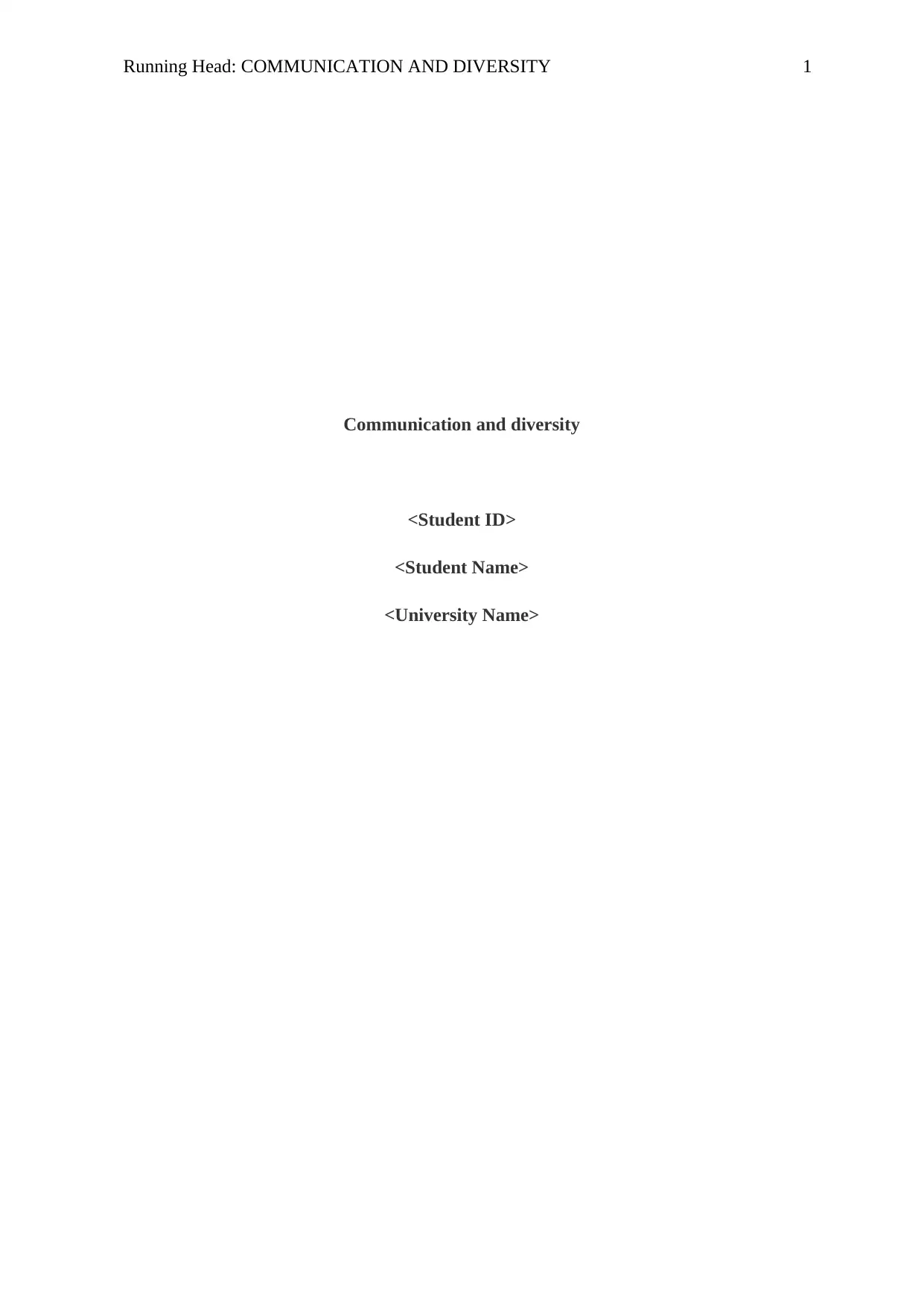
Running Head: COMMUNICATION AND DIVERSITY 1
Communication and diversity
<Student ID>
<Student Name>
<University Name>
Communication and diversity
<Student ID>
<Student Name>
<University Name>
Secure Best Marks with AI Grader
Need help grading? Try our AI Grader for instant feedback on your assignments.
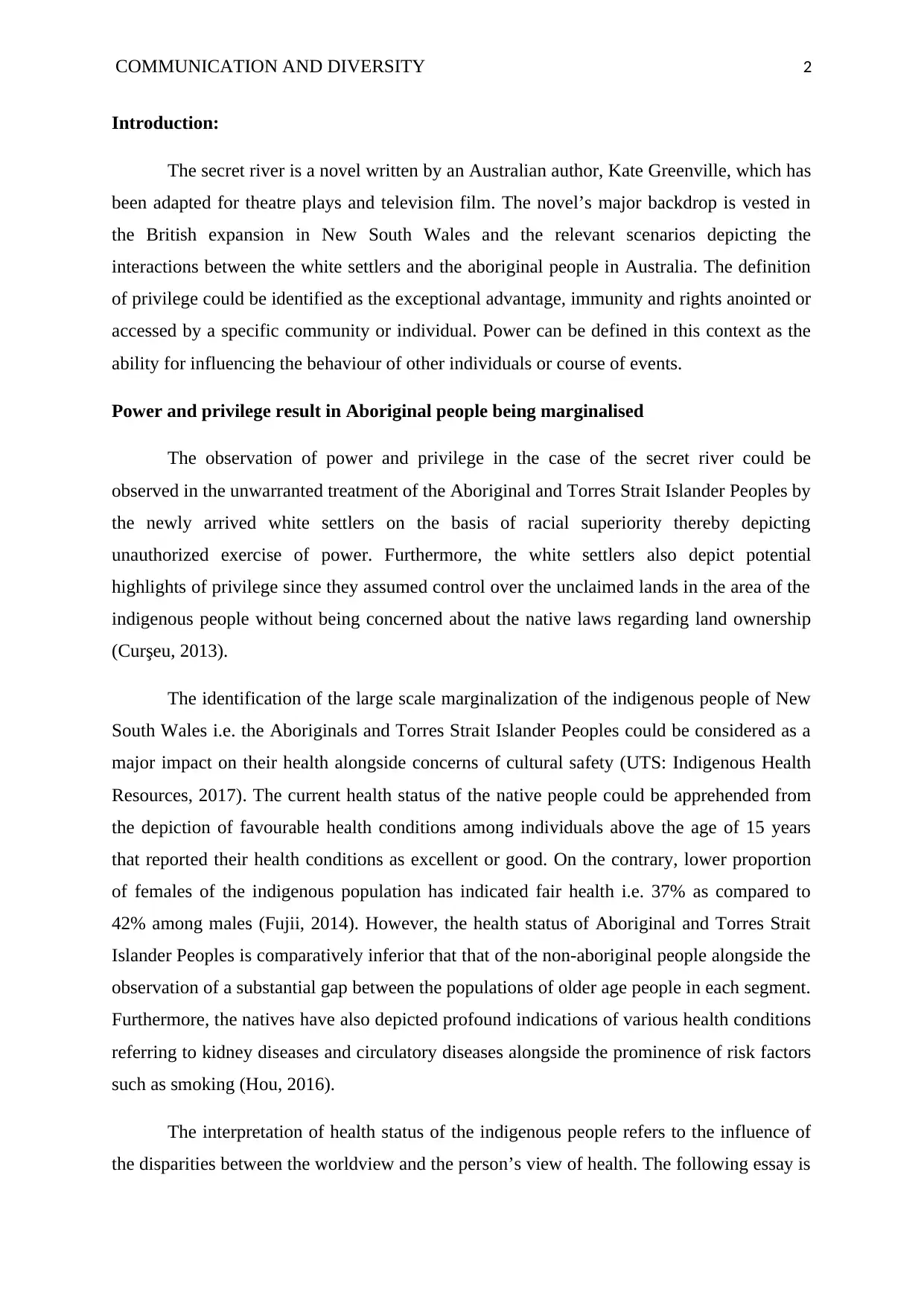
COMMUNICATION AND DIVERSITY 2
Introduction:
The secret river is a novel written by an Australian author, Kate Greenville, which has
been adapted for theatre plays and television film. The novel’s major backdrop is vested in
the British expansion in New South Wales and the relevant scenarios depicting the
interactions between the white settlers and the aboriginal people in Australia. The definition
of privilege could be identified as the exceptional advantage, immunity and rights anointed or
accessed by a specific community or individual. Power can be defined in this context as the
ability for influencing the behaviour of other individuals or course of events.
Power and privilege result in Aboriginal people being marginalised
The observation of power and privilege in the case of the secret river could be
observed in the unwarranted treatment of the Aboriginal and Torres Strait Islander Peoples by
the newly arrived white settlers on the basis of racial superiority thereby depicting
unauthorized exercise of power. Furthermore, the white settlers also depict potential
highlights of privilege since they assumed control over the unclaimed lands in the area of the
indigenous people without being concerned about the native laws regarding land ownership
(Curşeu, 2013).
The identification of the large scale marginalization of the indigenous people of New
South Wales i.e. the Aboriginals and Torres Strait Islander Peoples could be considered as a
major impact on their health alongside concerns of cultural safety (UTS: Indigenous Health
Resources, 2017). The current health status of the native people could be apprehended from
the depiction of favourable health conditions among individuals above the age of 15 years
that reported their health conditions as excellent or good. On the contrary, lower proportion
of females of the indigenous population has indicated fair health i.e. 37% as compared to
42% among males (Fujii, 2014). However, the health status of Aboriginal and Torres Strait
Islander Peoples is comparatively inferior that that of the non-aboriginal people alongside the
observation of a substantial gap between the populations of older age people in each segment.
Furthermore, the natives have also depicted profound indications of various health conditions
referring to kidney diseases and circulatory diseases alongside the prominence of risk factors
such as smoking (Hou, 2016).
The interpretation of health status of the indigenous people refers to the influence of
the disparities between the worldview and the person’s view of health. The following essay is
Introduction:
The secret river is a novel written by an Australian author, Kate Greenville, which has
been adapted for theatre plays and television film. The novel’s major backdrop is vested in
the British expansion in New South Wales and the relevant scenarios depicting the
interactions between the white settlers and the aboriginal people in Australia. The definition
of privilege could be identified as the exceptional advantage, immunity and rights anointed or
accessed by a specific community or individual. Power can be defined in this context as the
ability for influencing the behaviour of other individuals or course of events.
Power and privilege result in Aboriginal people being marginalised
The observation of power and privilege in the case of the secret river could be
observed in the unwarranted treatment of the Aboriginal and Torres Strait Islander Peoples by
the newly arrived white settlers on the basis of racial superiority thereby depicting
unauthorized exercise of power. Furthermore, the white settlers also depict potential
highlights of privilege since they assumed control over the unclaimed lands in the area of the
indigenous people without being concerned about the native laws regarding land ownership
(Curşeu, 2013).
The identification of the large scale marginalization of the indigenous people of New
South Wales i.e. the Aboriginals and Torres Strait Islander Peoples could be considered as a
major impact on their health alongside concerns of cultural safety (UTS: Indigenous Health
Resources, 2017). The current health status of the native people could be apprehended from
the depiction of favourable health conditions among individuals above the age of 15 years
that reported their health conditions as excellent or good. On the contrary, lower proportion
of females of the indigenous population has indicated fair health i.e. 37% as compared to
42% among males (Fujii, 2014). However, the health status of Aboriginal and Torres Strait
Islander Peoples is comparatively inferior that that of the non-aboriginal people alongside the
observation of a substantial gap between the populations of older age people in each segment.
Furthermore, the natives have also depicted profound indications of various health conditions
referring to kidney diseases and circulatory diseases alongside the prominence of risk factors
such as smoking (Hou, 2016).
The interpretation of health status of the indigenous people refers to the influence of
the disparities between the worldview and the person’s view of health. The following essay is
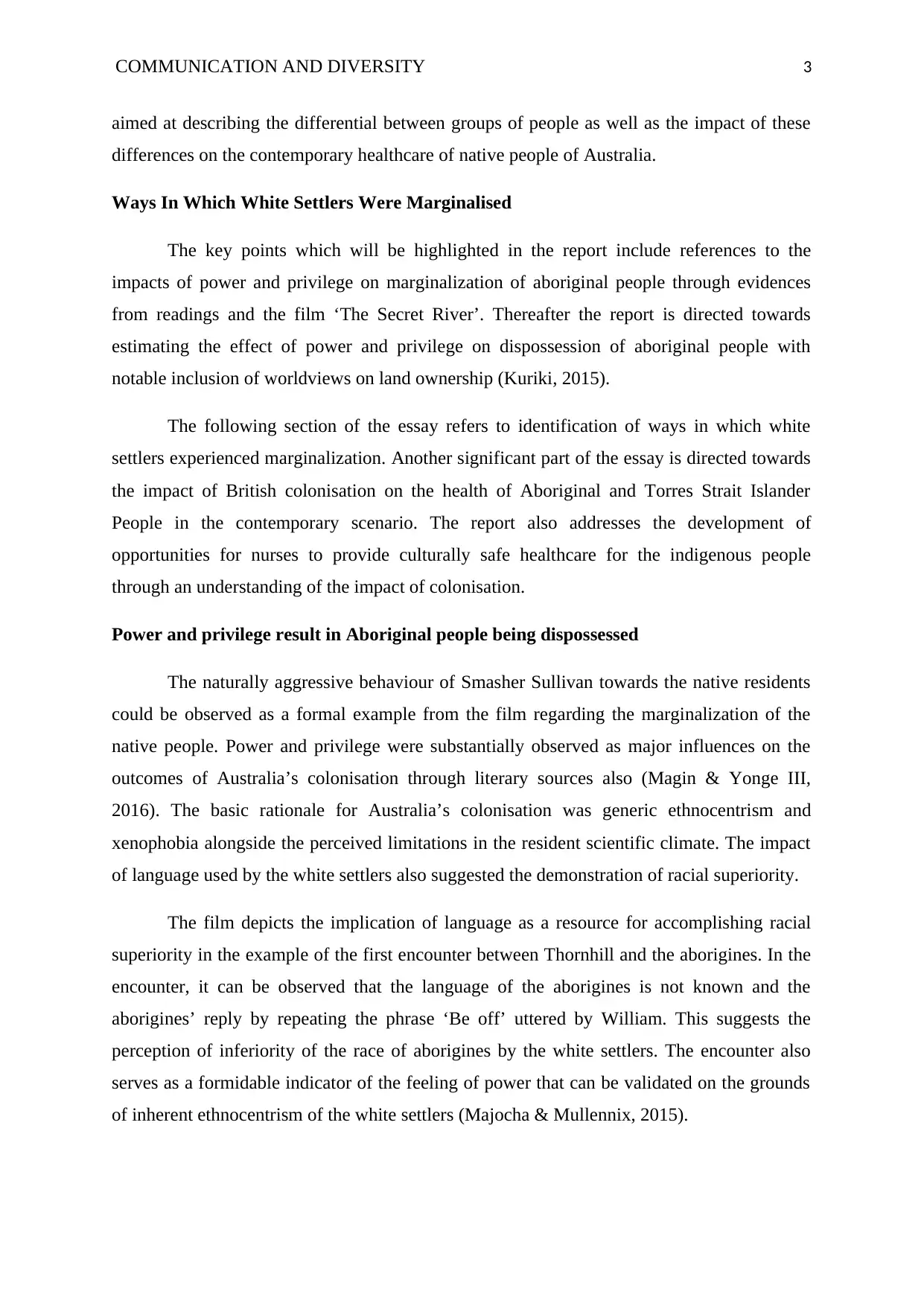
COMMUNICATION AND DIVERSITY 3
aimed at describing the differential between groups of people as well as the impact of these
differences on the contemporary healthcare of native people of Australia.
Ways In Which White Settlers Were Marginalised
The key points which will be highlighted in the report include references to the
impacts of power and privilege on marginalization of aboriginal people through evidences
from readings and the film ‘The Secret River’. Thereafter the report is directed towards
estimating the effect of power and privilege on dispossession of aboriginal people with
notable inclusion of worldviews on land ownership (Kuriki, 2015).
The following section of the essay refers to identification of ways in which white
settlers experienced marginalization. Another significant part of the essay is directed towards
the impact of British colonisation on the health of Aboriginal and Torres Strait Islander
People in the contemporary scenario. The report also addresses the development of
opportunities for nurses to provide culturally safe healthcare for the indigenous people
through an understanding of the impact of colonisation.
Power and privilege result in Aboriginal people being dispossessed
The naturally aggressive behaviour of Smasher Sullivan towards the native residents
could be observed as a formal example from the film regarding the marginalization of the
native people. Power and privilege were substantially observed as major influences on the
outcomes of Australia’s colonisation through literary sources also (Magin & Yonge III,
2016). The basic rationale for Australia’s colonisation was generic ethnocentrism and
xenophobia alongside the perceived limitations in the resident scientific climate. The impact
of language used by the white settlers also suggested the demonstration of racial superiority.
The film depicts the implication of language as a resource for accomplishing racial
superiority in the example of the first encounter between Thornhill and the aborigines. In the
encounter, it can be observed that the language of the aborigines is not known and the
aborigines’ reply by repeating the phrase ‘Be off’ uttered by William. This suggests the
perception of inferiority of the race of aborigines by the white settlers. The encounter also
serves as a formidable indicator of the feeling of power that can be validated on the grounds
of inherent ethnocentrism of the white settlers (Majocha & Mullennix, 2015).
aimed at describing the differential between groups of people as well as the impact of these
differences on the contemporary healthcare of native people of Australia.
Ways In Which White Settlers Were Marginalised
The key points which will be highlighted in the report include references to the
impacts of power and privilege on marginalization of aboriginal people through evidences
from readings and the film ‘The Secret River’. Thereafter the report is directed towards
estimating the effect of power and privilege on dispossession of aboriginal people with
notable inclusion of worldviews on land ownership (Kuriki, 2015).
The following section of the essay refers to identification of ways in which white
settlers experienced marginalization. Another significant part of the essay is directed towards
the impact of British colonisation on the health of Aboriginal and Torres Strait Islander
People in the contemporary scenario. The report also addresses the development of
opportunities for nurses to provide culturally safe healthcare for the indigenous people
through an understanding of the impact of colonisation.
Power and privilege result in Aboriginal people being dispossessed
The naturally aggressive behaviour of Smasher Sullivan towards the native residents
could be observed as a formal example from the film regarding the marginalization of the
native people. Power and privilege were substantially observed as major influences on the
outcomes of Australia’s colonisation through literary sources also (Magin & Yonge III,
2016). The basic rationale for Australia’s colonisation was generic ethnocentrism and
xenophobia alongside the perceived limitations in the resident scientific climate. The impact
of language used by the white settlers also suggested the demonstration of racial superiority.
The film depicts the implication of language as a resource for accomplishing racial
superiority in the example of the first encounter between Thornhill and the aborigines. In the
encounter, it can be observed that the language of the aborigines is not known and the
aborigines’ reply by repeating the phrase ‘Be off’ uttered by William. This suggests the
perception of inferiority of the race of aborigines by the white settlers. The encounter also
serves as a formidable indicator of the feeling of power that can be validated on the grounds
of inherent ethnocentrism of the white settlers (Majocha & Mullennix, 2015).
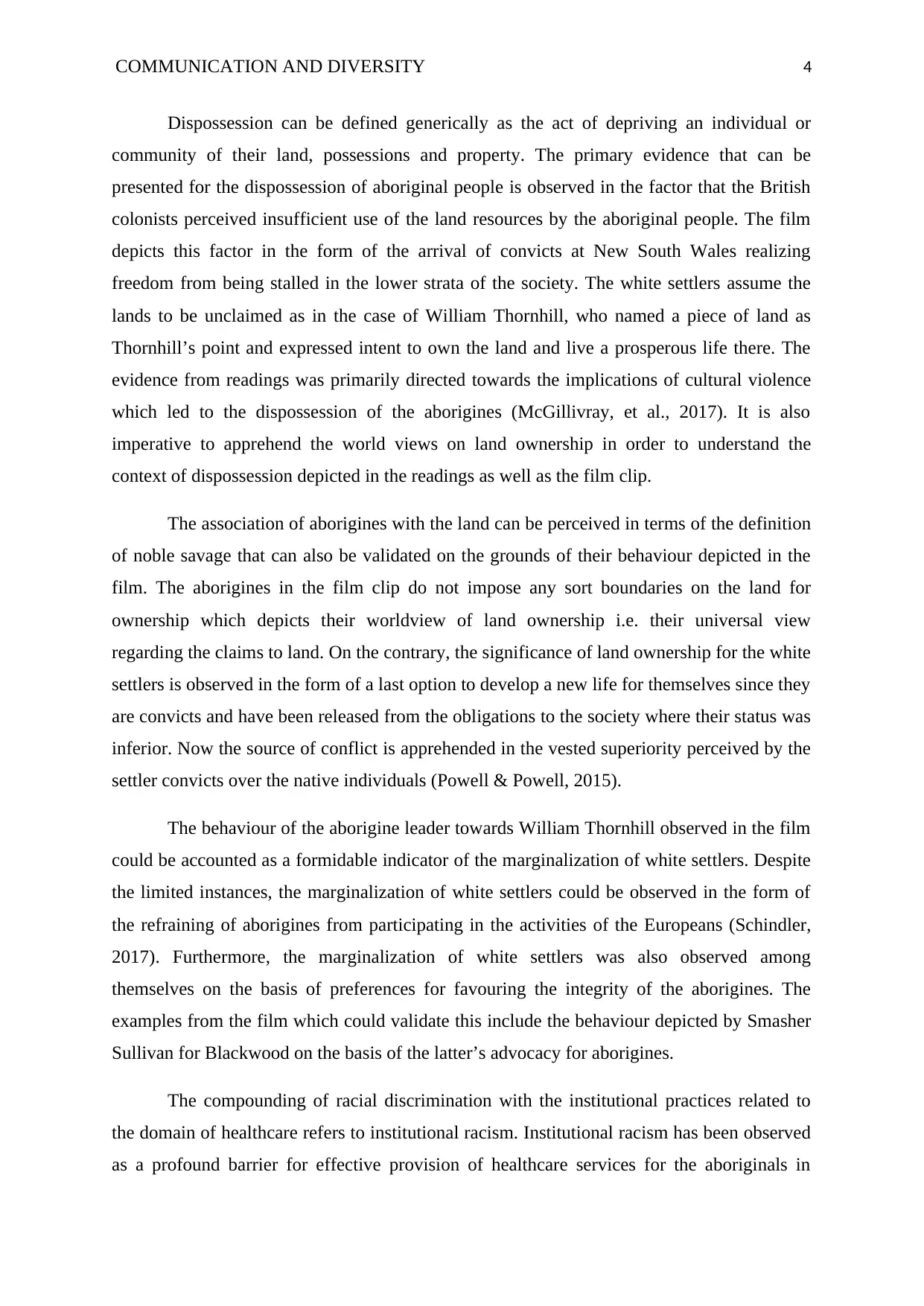
COMMUNICATION AND DIVERSITY 4
Dispossession can be defined generically as the act of depriving an individual or
community of their land, possessions and property. The primary evidence that can be
presented for the dispossession of aboriginal people is observed in the factor that the British
colonists perceived insufficient use of the land resources by the aboriginal people. The film
depicts this factor in the form of the arrival of convicts at New South Wales realizing
freedom from being stalled in the lower strata of the society. The white settlers assume the
lands to be unclaimed as in the case of William Thornhill, who named a piece of land as
Thornhill’s point and expressed intent to own the land and live a prosperous life there. The
evidence from readings was primarily directed towards the implications of cultural violence
which led to the dispossession of the aborigines (McGillivray, et al., 2017). It is also
imperative to apprehend the world views on land ownership in order to understand the
context of dispossession depicted in the readings as well as the film clip.
The association of aborigines with the land can be perceived in terms of the definition
of noble savage that can also be validated on the grounds of their behaviour depicted in the
film. The aborigines in the film clip do not impose any sort boundaries on the land for
ownership which depicts their worldview of land ownership i.e. their universal view
regarding the claims to land. On the contrary, the significance of land ownership for the white
settlers is observed in the form of a last option to develop a new life for themselves since they
are convicts and have been released from the obligations to the society where their status was
inferior. Now the source of conflict is apprehended in the vested superiority perceived by the
settler convicts over the native individuals (Powell & Powell, 2015).
The behaviour of the aborigine leader towards William Thornhill observed in the film
could be accounted as a formidable indicator of the marginalization of white settlers. Despite
the limited instances, the marginalization of white settlers could be observed in the form of
the refraining of aborigines from participating in the activities of the Europeans (Schindler,
2017). Furthermore, the marginalization of white settlers was also observed among
themselves on the basis of preferences for favouring the integrity of the aborigines. The
examples from the film which could validate this include the behaviour depicted by Smasher
Sullivan for Blackwood on the basis of the latter’s advocacy for aborigines.
The compounding of racial discrimination with the institutional practices related to
the domain of healthcare refers to institutional racism. Institutional racism has been observed
as a profound barrier for effective provision of healthcare services for the aboriginals in
Dispossession can be defined generically as the act of depriving an individual or
community of their land, possessions and property. The primary evidence that can be
presented for the dispossession of aboriginal people is observed in the factor that the British
colonists perceived insufficient use of the land resources by the aboriginal people. The film
depicts this factor in the form of the arrival of convicts at New South Wales realizing
freedom from being stalled in the lower strata of the society. The white settlers assume the
lands to be unclaimed as in the case of William Thornhill, who named a piece of land as
Thornhill’s point and expressed intent to own the land and live a prosperous life there. The
evidence from readings was primarily directed towards the implications of cultural violence
which led to the dispossession of the aborigines (McGillivray, et al., 2017). It is also
imperative to apprehend the world views on land ownership in order to understand the
context of dispossession depicted in the readings as well as the film clip.
The association of aborigines with the land can be perceived in terms of the definition
of noble savage that can also be validated on the grounds of their behaviour depicted in the
film. The aborigines in the film clip do not impose any sort boundaries on the land for
ownership which depicts their worldview of land ownership i.e. their universal view
regarding the claims to land. On the contrary, the significance of land ownership for the white
settlers is observed in the form of a last option to develop a new life for themselves since they
are convicts and have been released from the obligations to the society where their status was
inferior. Now the source of conflict is apprehended in the vested superiority perceived by the
settler convicts over the native individuals (Powell & Powell, 2015).
The behaviour of the aborigine leader towards William Thornhill observed in the film
could be accounted as a formidable indicator of the marginalization of white settlers. Despite
the limited instances, the marginalization of white settlers could be observed in the form of
the refraining of aborigines from participating in the activities of the Europeans (Schindler,
2017). Furthermore, the marginalization of white settlers was also observed among
themselves on the basis of preferences for favouring the integrity of the aborigines. The
examples from the film which could validate this include the behaviour depicted by Smasher
Sullivan for Blackwood on the basis of the latter’s advocacy for aborigines.
The compounding of racial discrimination with the institutional practices related to
the domain of healthcare refers to institutional racism. Institutional racism has been observed
as a profound barrier for effective provision of healthcare services for the aboriginals in
Secure Best Marks with AI Grader
Need help grading? Try our AI Grader for instant feedback on your assignments.
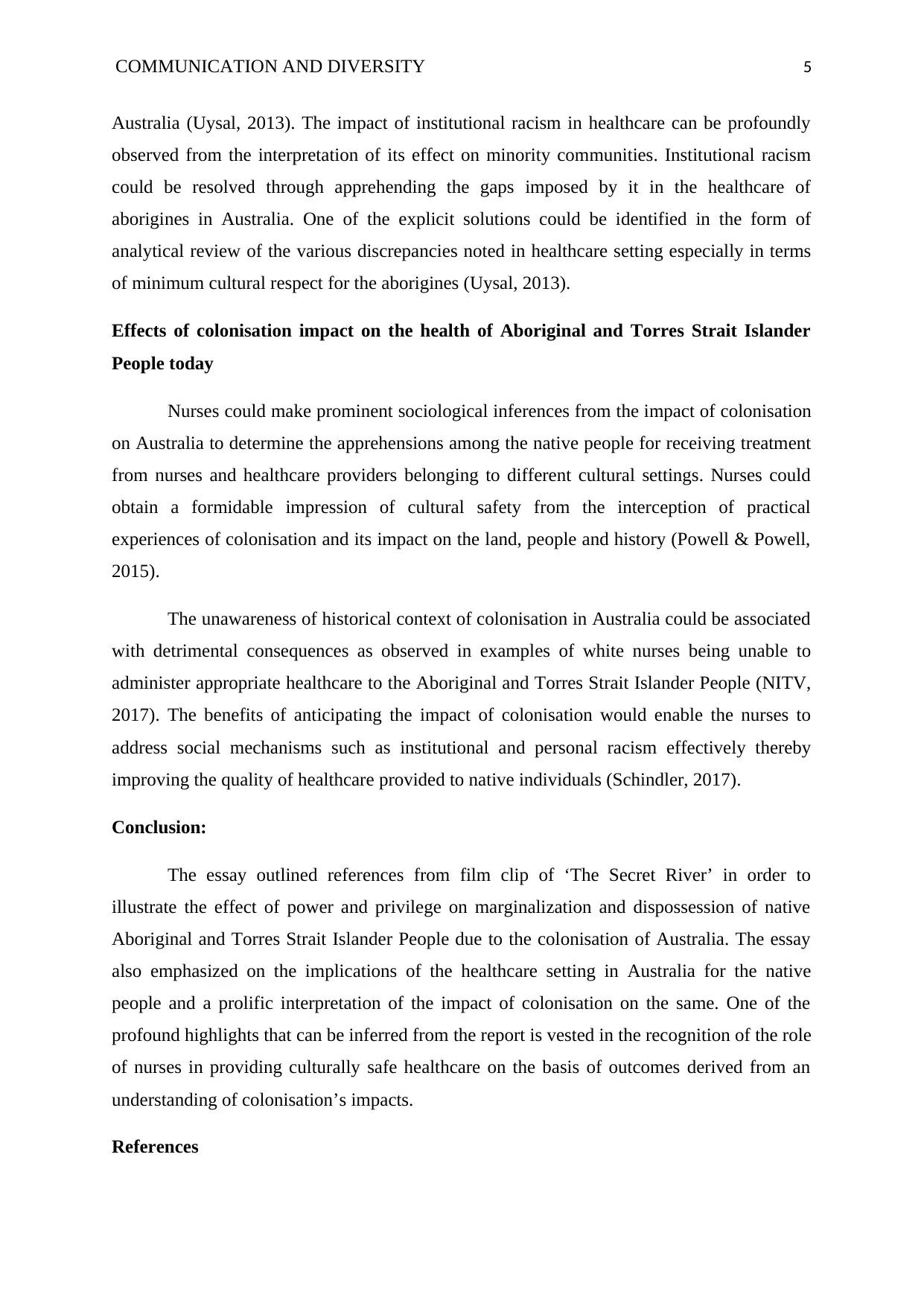
COMMUNICATION AND DIVERSITY 5
Australia (Uysal, 2013). The impact of institutional racism in healthcare can be profoundly
observed from the interpretation of its effect on minority communities. Institutional racism
could be resolved through apprehending the gaps imposed by it in the healthcare of
aborigines in Australia. One of the explicit solutions could be identified in the form of
analytical review of the various discrepancies noted in healthcare setting especially in terms
of minimum cultural respect for the aborigines (Uysal, 2013).
Effects of colonisation impact on the health of Aboriginal and Torres Strait Islander
People today
Nurses could make prominent sociological inferences from the impact of colonisation
on Australia to determine the apprehensions among the native people for receiving treatment
from nurses and healthcare providers belonging to different cultural settings. Nurses could
obtain a formidable impression of cultural safety from the interception of practical
experiences of colonisation and its impact on the land, people and history (Powell & Powell,
2015).
The unawareness of historical context of colonisation in Australia could be associated
with detrimental consequences as observed in examples of white nurses being unable to
administer appropriate healthcare to the Aboriginal and Torres Strait Islander People (NITV,
2017). The benefits of anticipating the impact of colonisation would enable the nurses to
address social mechanisms such as institutional and personal racism effectively thereby
improving the quality of healthcare provided to native individuals (Schindler, 2017).
Conclusion:
The essay outlined references from film clip of ‘The Secret River’ in order to
illustrate the effect of power and privilege on marginalization and dispossession of native
Aboriginal and Torres Strait Islander People due to the colonisation of Australia. The essay
also emphasized on the implications of the healthcare setting in Australia for the native
people and a prolific interpretation of the impact of colonisation on the same. One of the
profound highlights that can be inferred from the report is vested in the recognition of the role
of nurses in providing culturally safe healthcare on the basis of outcomes derived from an
understanding of colonisation’s impacts.
References
Australia (Uysal, 2013). The impact of institutional racism in healthcare can be profoundly
observed from the interpretation of its effect on minority communities. Institutional racism
could be resolved through apprehending the gaps imposed by it in the healthcare of
aborigines in Australia. One of the explicit solutions could be identified in the form of
analytical review of the various discrepancies noted in healthcare setting especially in terms
of minimum cultural respect for the aborigines (Uysal, 2013).
Effects of colonisation impact on the health of Aboriginal and Torres Strait Islander
People today
Nurses could make prominent sociological inferences from the impact of colonisation
on Australia to determine the apprehensions among the native people for receiving treatment
from nurses and healthcare providers belonging to different cultural settings. Nurses could
obtain a formidable impression of cultural safety from the interception of practical
experiences of colonisation and its impact on the land, people and history (Powell & Powell,
2015).
The unawareness of historical context of colonisation in Australia could be associated
with detrimental consequences as observed in examples of white nurses being unable to
administer appropriate healthcare to the Aboriginal and Torres Strait Islander People (NITV,
2017). The benefits of anticipating the impact of colonisation would enable the nurses to
address social mechanisms such as institutional and personal racism effectively thereby
improving the quality of healthcare provided to native individuals (Schindler, 2017).
Conclusion:
The essay outlined references from film clip of ‘The Secret River’ in order to
illustrate the effect of power and privilege on marginalization and dispossession of native
Aboriginal and Torres Strait Islander People due to the colonisation of Australia. The essay
also emphasized on the implications of the healthcare setting in Australia for the native
people and a prolific interpretation of the impact of colonisation on the same. One of the
profound highlights that can be inferred from the report is vested in the recognition of the role
of nurses in providing culturally safe healthcare on the basis of outcomes derived from an
understanding of colonisation’s impacts.
References
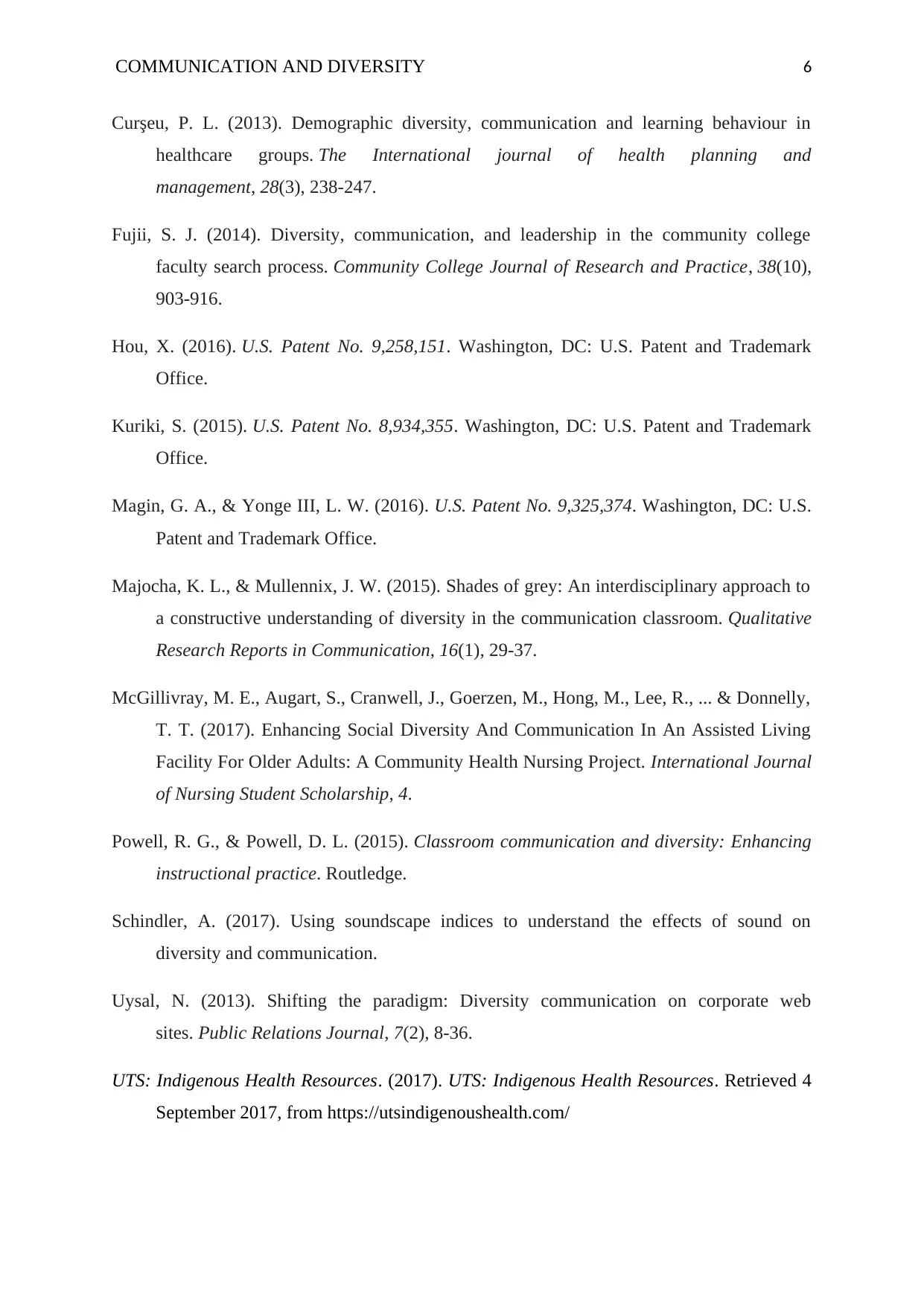
COMMUNICATION AND DIVERSITY 6
Curşeu, P. L. (2013). Demographic diversity, communication and learning behaviour in
healthcare groups. The International journal of health planning and
management, 28(3), 238-247.
Fujii, S. J. (2014). Diversity, communication, and leadership in the community college
faculty search process. Community College Journal of Research and Practice, 38(10),
903-916.
Hou, X. (2016). U.S. Patent No. 9,258,151. Washington, DC: U.S. Patent and Trademark
Office.
Kuriki, S. (2015). U.S. Patent No. 8,934,355. Washington, DC: U.S. Patent and Trademark
Office.
Magin, G. A., & Yonge III, L. W. (2016). U.S. Patent No. 9,325,374. Washington, DC: U.S.
Patent and Trademark Office.
Majocha, K. L., & Mullennix, J. W. (2015). Shades of grey: An interdisciplinary approach to
a constructive understanding of diversity in the communication classroom. Qualitative
Research Reports in Communication, 16(1), 29-37.
McGillivray, M. E., Augart, S., Cranwell, J., Goerzen, M., Hong, M., Lee, R., ... & Donnelly,
T. T. (2017). Enhancing Social Diversity And Communication In An Assisted Living
Facility For Older Adults: A Community Health Nursing Project. International Journal
of Nursing Student Scholarship, 4.
Powell, R. G., & Powell, D. L. (2015). Classroom communication and diversity: Enhancing
instructional practice. Routledge.
Schindler, A. (2017). Using soundscape indices to understand the effects of sound on
diversity and communication.
Uysal, N. (2013). Shifting the paradigm: Diversity communication on corporate web
sites. Public Relations Journal, 7(2), 8-36.
UTS: Indigenous Health Resources. (2017). UTS: Indigenous Health Resources. Retrieved 4
September 2017, from https://utsindigenoushealth.com/
Curşeu, P. L. (2013). Demographic diversity, communication and learning behaviour in
healthcare groups. The International journal of health planning and
management, 28(3), 238-247.
Fujii, S. J. (2014). Diversity, communication, and leadership in the community college
faculty search process. Community College Journal of Research and Practice, 38(10),
903-916.
Hou, X. (2016). U.S. Patent No. 9,258,151. Washington, DC: U.S. Patent and Trademark
Office.
Kuriki, S. (2015). U.S. Patent No. 8,934,355. Washington, DC: U.S. Patent and Trademark
Office.
Magin, G. A., & Yonge III, L. W. (2016). U.S. Patent No. 9,325,374. Washington, DC: U.S.
Patent and Trademark Office.
Majocha, K. L., & Mullennix, J. W. (2015). Shades of grey: An interdisciplinary approach to
a constructive understanding of diversity in the communication classroom. Qualitative
Research Reports in Communication, 16(1), 29-37.
McGillivray, M. E., Augart, S., Cranwell, J., Goerzen, M., Hong, M., Lee, R., ... & Donnelly,
T. T. (2017). Enhancing Social Diversity And Communication In An Assisted Living
Facility For Older Adults: A Community Health Nursing Project. International Journal
of Nursing Student Scholarship, 4.
Powell, R. G., & Powell, D. L. (2015). Classroom communication and diversity: Enhancing
instructional practice. Routledge.
Schindler, A. (2017). Using soundscape indices to understand the effects of sound on
diversity and communication.
Uysal, N. (2013). Shifting the paradigm: Diversity communication on corporate web
sites. Public Relations Journal, 7(2), 8-36.
UTS: Indigenous Health Resources. (2017). UTS: Indigenous Health Resources. Retrieved 4
September 2017, from https://utsindigenoushealth.com/
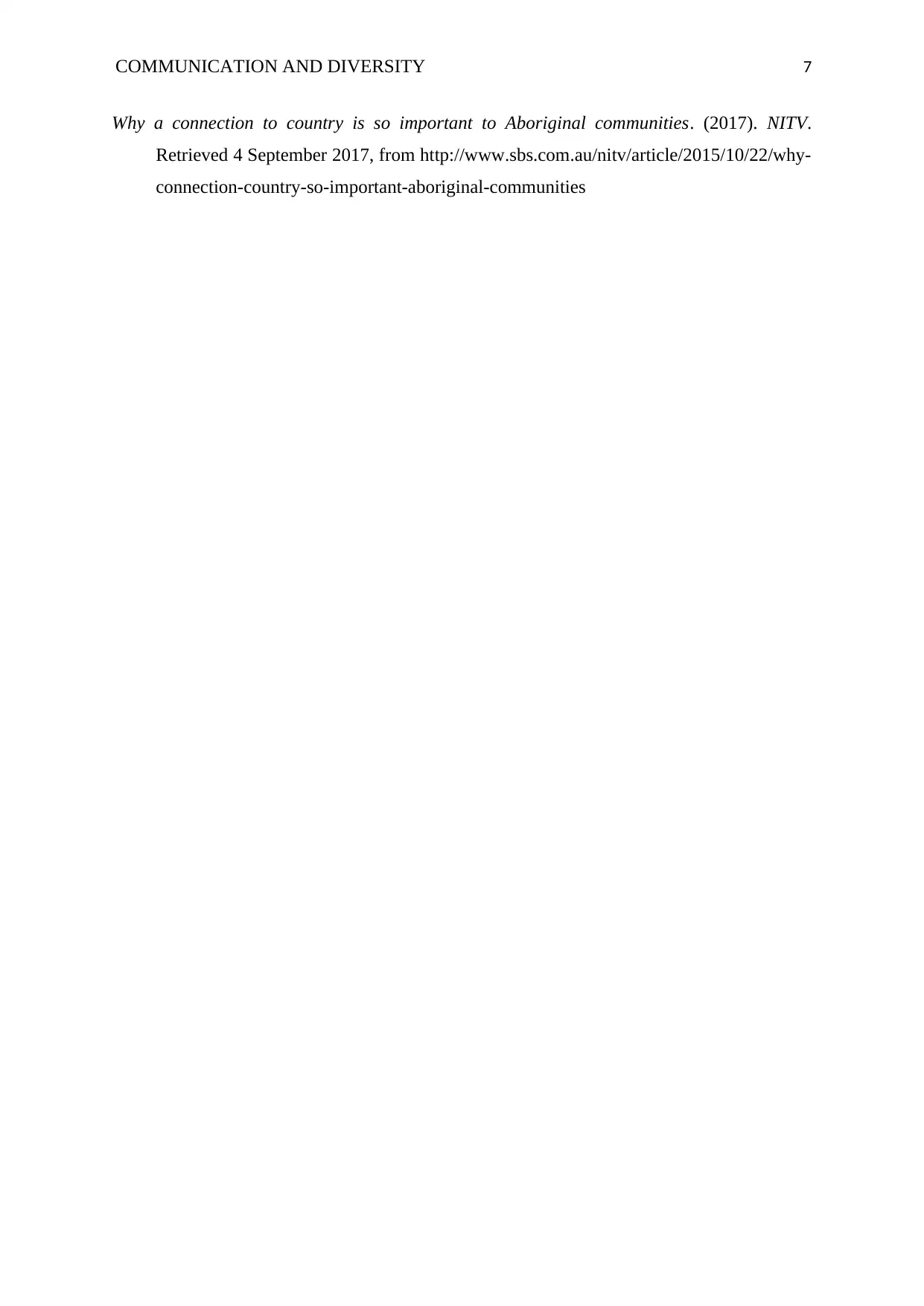
COMMUNICATION AND DIVERSITY 7
Why a connection to country is so important to Aboriginal communities. (2017). NITV.
Retrieved 4 September 2017, from http://www.sbs.com.au/nitv/article/2015/10/22/why-
connection-country-so-important-aboriginal-communities
Why a connection to country is so important to Aboriginal communities. (2017). NITV.
Retrieved 4 September 2017, from http://www.sbs.com.au/nitv/article/2015/10/22/why-
connection-country-so-important-aboriginal-communities
1 out of 7
Related Documents
Your All-in-One AI-Powered Toolkit for Academic Success.
+13062052269
info@desklib.com
Available 24*7 on WhatsApp / Email
![[object Object]](/_next/static/media/star-bottom.7253800d.svg)
Unlock your academic potential
© 2024 | Zucol Services PVT LTD | All rights reserved.





